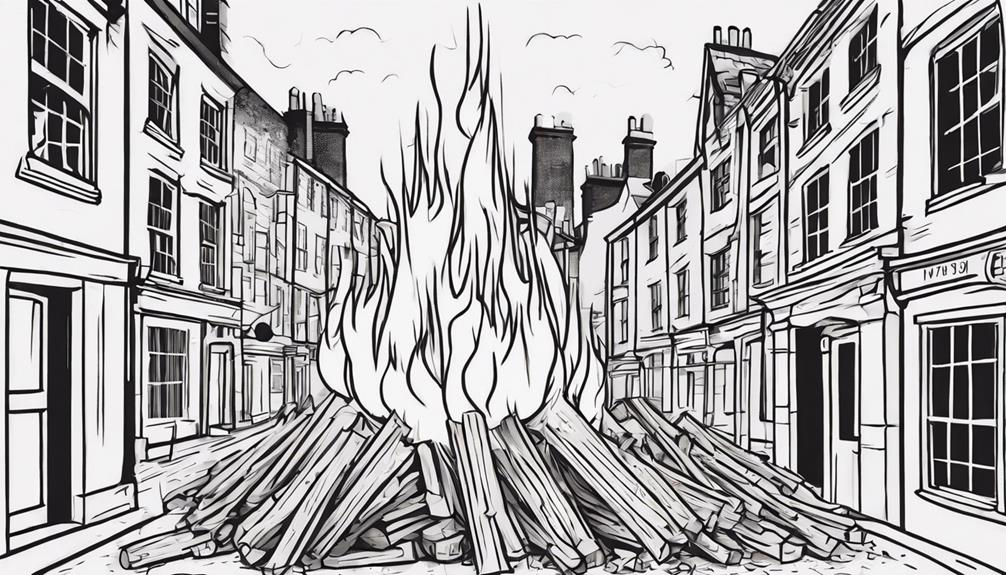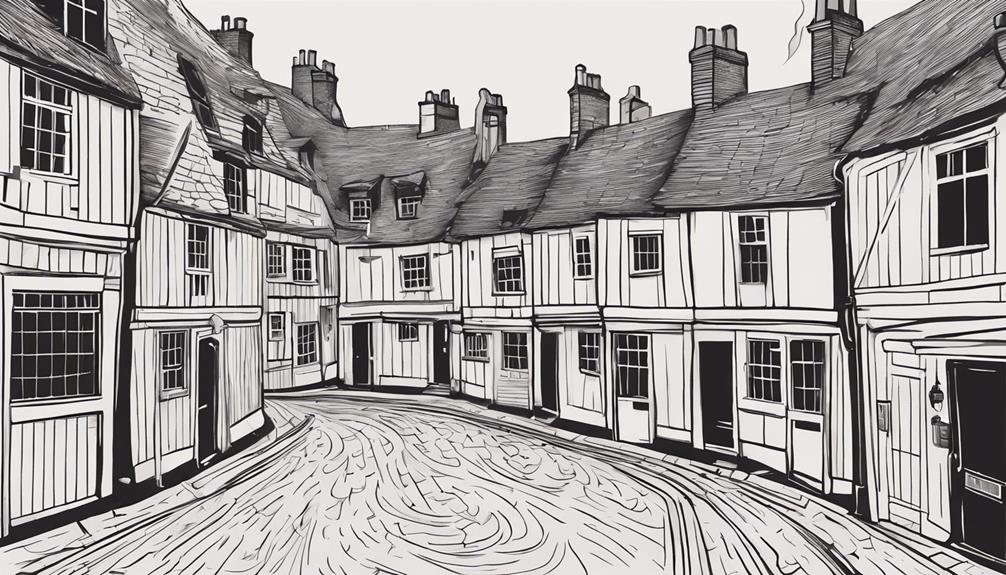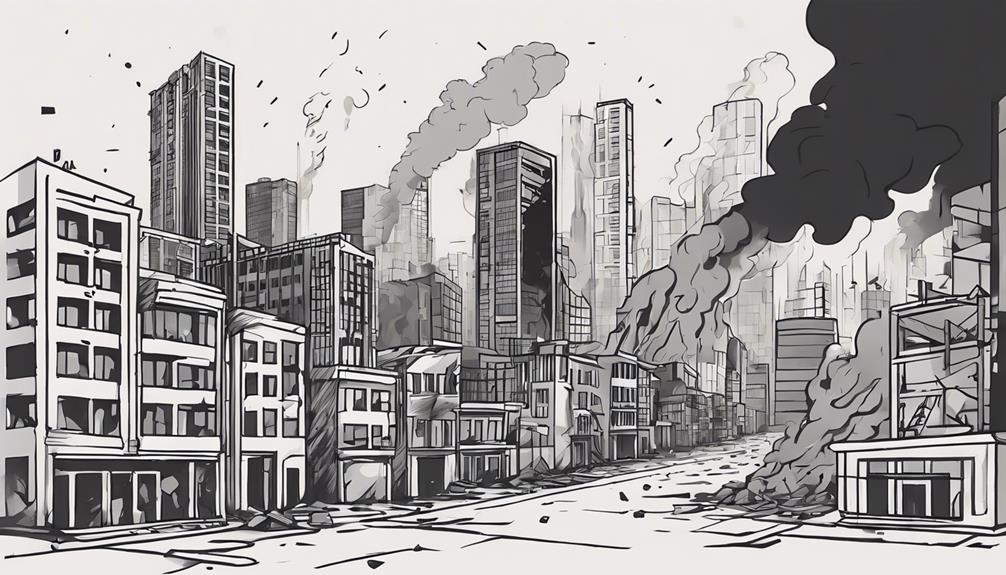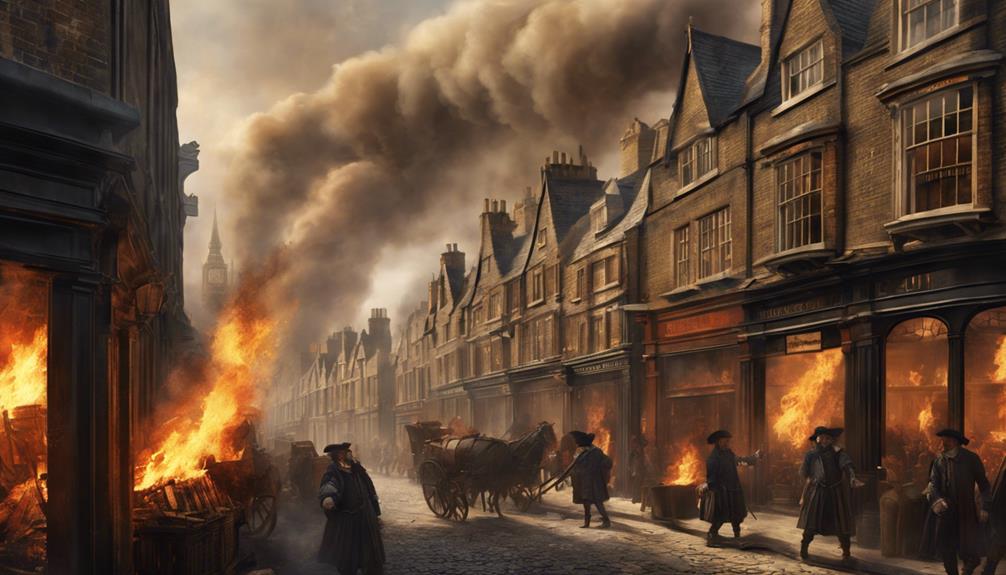The Great Fire of London remains a pivotal event in history, sparking debates and inquiries into its origin and the circumstances that led to its devastating consequences. While the initial spark at Thomas Farriner's bakery on Pudding Lane is widely acknowledged, the intricate chain of events that followed and the environmental factors that amplified the inferno are subjects of continued scrutiny. By exploring the various catalysts and conditions, we can gain a deeper understanding of how this catastrophe unfolded and the lessons it imparts for future urban planning and disaster management.
Key Takeaways
- The fire originated at Thomas Farriner's bakery on Pudding Lane.
- Intense heat, strong winds, and flammable structures fueled the fire's rapid spread.
- Lack of centralized fire services and rudimentary firefighting tools hindered control efforts.
- Legacy includes rebuilt infrastructure, fire brigades, and redesigned iconic landmarks by Sir Christopher Wren.
The Spark That Ignited Disaster

The ignition source of the catastrophic Great Fire of London can be traced back to a spark originating in the bakery of Thomas Farriner on Pudding Lane. Thomas Farriner, the King's baker, unintentionally set in motion a series of events that led to the devastation of a significant part of London. It is reported that Farriner was attempting to extinguish a small blaze in his bakery when the spark ignited nearby combustible materials, resulting in the rapid spread of the fire.
The location of Farriner's bakery on Pudding Lane, surrounded by warehouses storing flammable goods, further fueled the catastrophic nature of the fire. Additionally, the presence of strong east winds on that fateful Sunday, 2nd September 1666, accelerated the spread of the flames down Pudding Lane and Fish Hill, causing widespread destruction.
Chain of Events Unleashing Tragedy
Following the ignition at Thomas Farriner's bakery, a series of interconnected events unfolded, ultimately leading to the tragic devastation of a significant part of London during the Great Fire of 1666. The spark at the bakery quickly found ample fuel in the predominantly wooden and straw-built structures of 17th century London. Fueled by strong east winds, the fire rapidly progressed down Pudding Lane and Fish Hill, engulfing everything in its path. As the flames reached the Thames River, warehouses along the waterfront became infernos, adding to the chaos. Interestingly, previous fires in the area actually played a role in preventing the fire from spreading further southward, containing the tragedy to a specific area. This chain of events, from the initial spark to the widespread devastation, highlights how a combination of environmental conditions, architectural materials, and historical circumstances can converge to unleash a catastrophe of immense proportions.
Factors Aiding Fire's Rampage

Under the prevailing weather conditions of intense heat and strong winds, the Great Fire of London found ideal circumstances to rapidly consume the densely packed wooden structures of the city in 1666. The fire, which originated in Thomas Farriner's bakery on Pudding Lane, quickly spread due to the abundance of flammable wooden houses in close proximity to each other. The lack of a centralized fire service further exacerbated the situation, as there was no coordinated effort to combat the flames effectively.
Londoners, including notable figures like Robert Hooke and Samuel Pepys, attempted to extinguish the fire using rudimentary tools such as leather buckets and water squirts. However, these efforts were largely futile against the sheer intensity and speed of the blaze. The fire's rampage was relentless, resulting in widespread destruction and chaos throughout the city.
The combination of dry weather, wooden infrastructure, and inadequate firefighting resources all played significant roles in fueling the Great Fire of London's devastating spread, leaving a lasting impact on 17th-century London.
Impact on 17th-Century London
Amidst the aftermath of the Great Fire of London's destructive path through the city in 1666, the profound impact on 17th-century London reverberated across social, economic, and architectural landscapes. The consequences of this catastrophic event were far-reaching:
- Homelessness: Over 70,000 individuals found themselves without homes, posing significant social challenges and displacing a large portion of the city's population.
- Economic Challenges: The destruction of approximately 13,200 houses and 87 churches led to economic turmoil, disrupting livelihoods and businesses.
- Rebuilding Efforts: The city faced extensive rebuilding efforts that spanned nearly 50 years to restore the decimated areas, showcasing the monumental task of reconstructing a city from the ashes.
The fire not only resulted in material losses but also sparked issues like theft, disease outbreaks, and the urgent need for temporary shelters, painting a grim picture of the struggles faced by the inhabitants of 17th-century London in the wake of this disaster.
Legacy of the Great Fire

The enduring legacy of the Great Fire of London encompasses the comprehensive reconstruction efforts that reshaped the city's urban landscape with enhanced infrastructure and architectural innovations. Following the devastation caused by the fire, London underwent a significant rebuilding process that led to the creation of wider streets and more durable buildings. This restructuring not only aimed at preventing future fires but also facilitated better urban planning and traffic flow within the city.
Moreover, the establishment of London's first fire brigades emerged as a direct response to the Great Fire, marking a crucial development in enhancing the city's firefighting capabilities. Architect Sir Christopher Wren played a pivotal role in the architectural redesign of iconic structures such as St. Paul's Cathedral, contributing to the city's post-fire transformation.
The construction of the Monument to the Great Fire of London near Pudding Lane stands as a poignant commemoration of the tragic event. The legacy of the Great Fire lives on through the enduring presence of these beautiful and iconic structures that continue to define London's skyline.
Frequently Asked Questions
Who Took the Blame for the Great Fire of London?
Various individuals, including Thomas Farriner, the King's baker, and his associates, initially faced blame as potential culprits for the Great Fire of London. The Royal scapegoat narrative led to legal repercussions and a blame game fueled by political fallout and public outcry. Conspiracy theories, historical revisionism, and a media frenzy ensued, shaping the cultural impact and legacy debated to this day. The shifting of blame highlighted the complexities of assigning fault in such a catastrophic event.
What Stopped the Great Fire of London?
In response to the question of what stopped the Great Fire of London, the coordinated efforts of firefighters, strategic use of water sources, wind direction, emergency plans, and urban layout played crucial roles. Effective communication methods, evacuation routes, and the use of advanced firefighting techniques further contributed to halting the fire's spread. Despite public panic and challenges posed by building materials, the combined efforts and strategic interventions successfully prevented further devastation.
Did the Great Fire of London Start the Plague?
The Great Fire of London did not directly start the plague outbreak in 1665. However, the fire's aftermath, including displacement of residents and changes in living conditions, could have influenced the spread of diseases like the plague. While separate events, both the fire and the plague had significant impacts on London's public health, urban development, and overall well-being during the 17th century, shaping the city's historical implications and cultural aftermath.
Why Did the Fire Spread so Quickly?
The rapid spread of the Great Fire of London can be attributed to a combination of factors such as the prevalent use of highly flammable building materials, specifically wooden structures with thatched roofs, coupled with dry weather conditions and strong winds that fueled the flames. Additionally, the dense urban planning and high population density facilitated the swift transmission of the fire from one building to another. Inadequate firefighting techniques and communication methods further impeded efforts to contain the fire effectively.
Conclusion
In conclusion, the Great Fire of London serves as a symbol of destruction and resilience in the face of adversity. The spark that ignited the disaster, the chain of events that unleashed tragedy, and the factors aiding the fire's rampage all highlight the vulnerability of densely populated urban areas. The impact on 17th-century London and the legacy of the Great Fire underscore the importance of fire safety measures and urban planning in preventing such catastrophes in the future.
